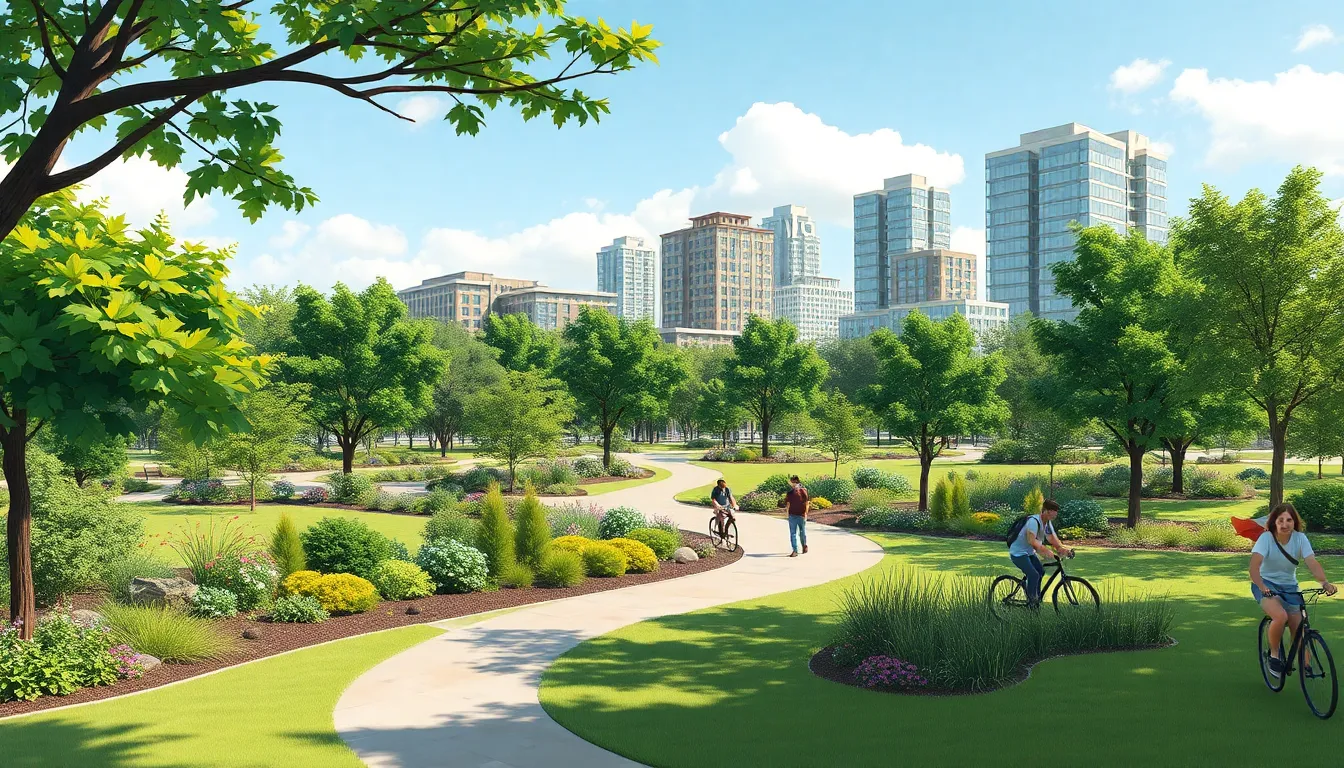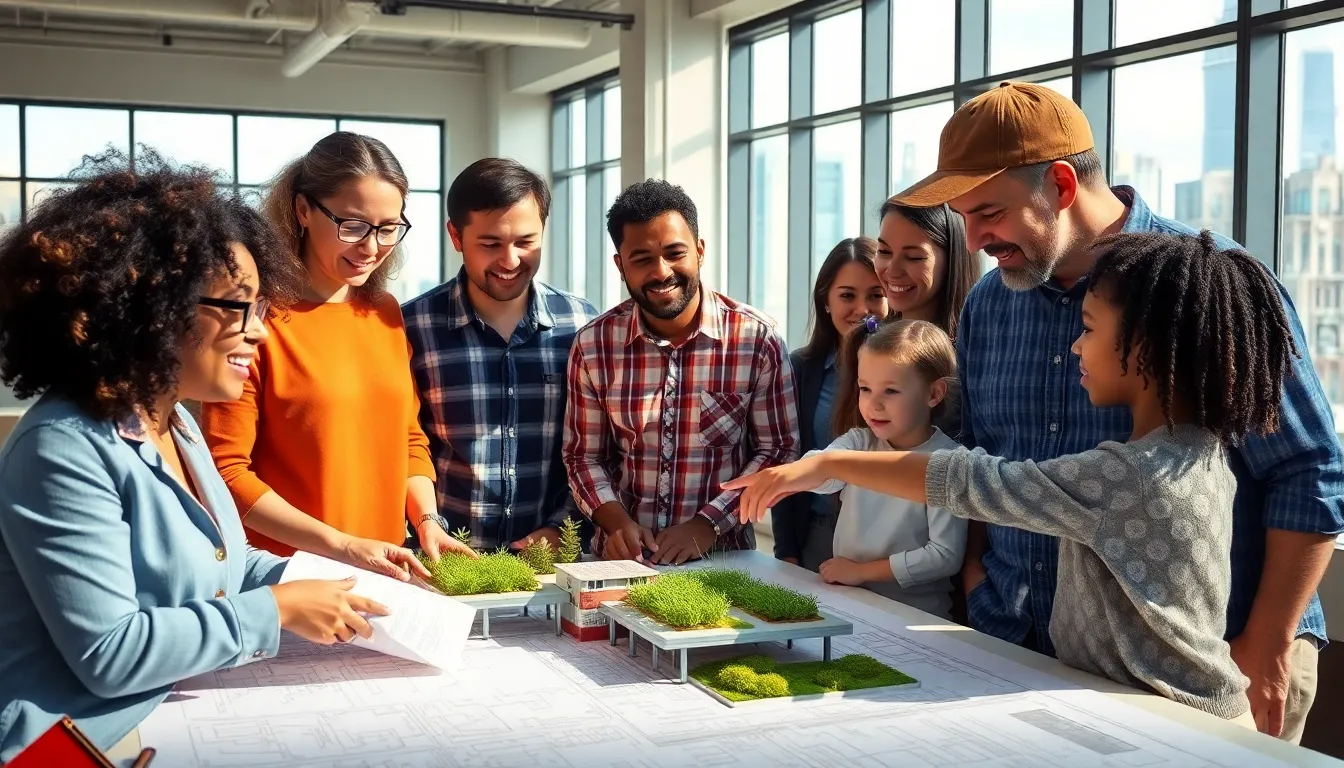In a world where concrete jungles seem to sprout overnight, eco-conscious urban planning is the superhero we didn’t know we needed. Imagine cities that don’t just house people but nurture the environment too. It’s like giving Mother Nature a cozy apartment right in the heart of the city.
Picture this: lush green rooftops, bike lanes that make cyclists feel like they’re gliding through a park, and buildings that breathe just like we do. Eco-conscious urban planning isn’t just about saving the planet; it’s about creating vibrant communities where people thrive. As cities grow, the challenge is to make them smarter, greener, and a lot more fun. After all, who wouldn’t want to live in a place that’s as friendly to the planet as it is to its residents? Let’s dive into how innovative designs and sustainable practices can transform urban living for the better.
Table of Contents
ToggleUnderstanding Eco-conscious Urban Planning
Eco-conscious urban planning focuses on creating sustainable and livable urban spaces. It aims to balance environmental, social, and economic needs within city developments.
Definition and Importance
Eco-conscious urban planning encompasses strategies designed to minimize negative environmental impacts while promoting sustainability. This approach prioritizes green spaces, efficient energy use, and sustainable transportation. Urban planners recognize this planning as vital for enhancing quality of life, reducing carbon footprints, and adapting to climate change. Cities that adopt these methods often see improvements in public health, community interaction, and economic vitality.
Key Principles
Several key principles define eco-conscious urban planning. These include sustainable land use, efficient resource management, and community engagement. Promoting public transportation and non-motorized travel fosters accessibility and reduces dependency on fossil fuels. Integrating green infrastructure, such as parks and green roofs, supports biodiversity and enhances residents’ well-being. Committing to renewable energy sources plays a pivotal role in decreasing urban energy demands while combating climate change.
Benefits of Eco-conscious Urban Planning

Eco-conscious urban planning offers numerous advantages that enhance city life. This approach prioritizes environmental sustainability, economic growth, and social equity.
Environmental Impact
Sustainable urban planning significantly reduces carbon footprints in cities. Green spaces contribute to improved air quality and biodiversity. Integrating trees and plants into urban areas can decrease heat island effects, creating cooler environments. Efficient transportation methods minimize pollution and foster eco-friendly commuting habits. Engaging in resource-efficient designs leads to lower energy consumption and waste generation. These measures effectively combat climate change while promoting healthier lifestyles.
Economic Benefits
Economic vitality thrives in eco-conscious urban areas. Sustainable developments attract businesses interested in environmentally friendly practices, boosting local job opportunities. Reduced energy costs result from energy-efficient buildings, benefitting both residents and businesses. Local governments save on infrastructure maintenance when investing in green technologies. Increased property values in green neighborhoods enhance economic success, encouraging community investment. Overall, eco-conscious urban planning stimulates economic growth while prioritizing ecological health.
Challenges in Implementing Eco-conscious Urban Planning
Implementing eco-conscious urban planning presents several significant challenges that must be addressed for sustainability efforts to succeed.
Financial Constraints
Budget limitations often hinder eco-conscious projects in urban areas. Many cities lack the necessary funding to invest in sustainable infrastructure, renewable energy sources, and green spaces. Prioritizing such initiatives requires creative funding solutions, like public-private partnerships or grants from environmental organizations. Without compelling financial backing, city planners may struggle to move forward with eco-friendly designs. Often, municipalities allocate budgets for immediate concerns, which detracts from long-term sustainability investments. Insufficient resources can stall green projects, delaying progress toward environmentally conscious goals.
Community Resistance
Community resistance poses another challenge to implementing eco-conscious urban planning. Residents sometimes fear change, preferring familiar environments over new developments. Engaging the community in the planning process fosters acceptance and enthusiasm for sustainable initiatives. Miscommunication often leads to misunderstandings about the benefits of eco-friendly projects. Addressing these concerns directly can build trust and encourage participation in planning stages. When citizens feel heard and involved, they are more likely to support green strategies for urban development. Collaborative approaches can transform resistance into advocacy for sustainable urban solutions.
Case Studies of Successful Eco-conscious Urban Planning
Cities around the globe showcase successful eco-conscious urban planning efforts. These case studies highlight innovative practices and lessons learned from both successes and challenges.
Innovative Cities Leading the Way
Copenhagen, Denmark, stands out as a leader in sustainable urban design. The city aims to become carbon neutral by 2025 by implementing extensive bicycle pathways, green roofs, and ambient urban spaces. Similarly, Vancouver, Canada, champions green initiatives through its Greenest City Action Plan, which fosters locally sourced food and renewable energy sources. Another example, Singapore, integrates nature within the urban fabric, featuring vertical gardens and an extensive park connector network, promoting biodiversity. These cities demonstrate how eco-friendly strategies not only improve quality of life but also drive economic growth.
Lessons Learned from Failures
Some eco-conscious projects struggled due to mismanagement or community pushback. A notable case involved the failed integration of green spaces in certain US cities, where budget cuts halted maintenance and implementation. In contrast, ineffective communication led to resistance against urban renewal efforts in a neighborhood in Australia. These challenges underscore the importance of engaging communities and maintaining project funding. Financial support and clear communication strategies are vital to ensuring sustainable practices not only launch successfully but also thrive over time.
Future Trends in Eco-conscious Urban Planning
Emerging technologies are transforming eco-conscious urban planning, enabling cities to adopt innovative approaches. Smart city initiatives leverage data analytics to improve resource efficiency and enhance quality of life. Cities increasingly utilize sensors and internet connectivity to monitor energy consumption and traffic patterns, leading to more sustainable urban environments.
Green building practices continue to evolve, with architects focusing on energy efficiency and sustainable materials. Passive design strategies maximize natural light and ventilation, significantly reducing reliance on artificial heating and cooling systems. Integrating renewable energy sources like solar panels and wind turbines into building designs fosters self-sufficiency and minimizes environmental impact.
Public transportation systems are seeing a shift towards electrification and increased accessibility. Cities are investing in electric buses and trams, promoting shifts away from fossil fuels and reducing air pollution. Expanding networks of bike lanes and pedestrian pathways encourages residents to embrace sustainable transportation options, improving urban mobility.
Urban agriculture is gaining traction as communities recognize the benefits of local food production. Rooftop gardens and community farms contribute to food security while also enhancing green spaces. Encouraging local food systems can enhance community engagement and provide a model for sustainable living.
Policy frameworks are increasingly reflecting the need for eco-conscious planning initiatives. Local governments are implementing incentives for green infrastructure projects, spurring investment in sustainable technologies. Collaborative partnerships between public and private sectors drive the development of eco-friendly urban spaces, ensuring sustainability goals remain a priority.
Engagement with communities is critical for success. When residents participate in the planning process, it fosters ownership and supports sustainable initiatives. Achieving balance between development and environmental preservation benefits all urban stakeholders, enhancing livability and resilience.
Eco-conscious urban planning represents a vital shift towards creating sustainable and livable cities. By prioritizing green infrastructure and community engagement, urban planners can foster environments that nurture both residents and the planet. The successful integration of innovative practices from cities around the world demonstrates the potential for positive change.
Addressing challenges through collaboration and creative funding solutions will pave the way for sustainable initiatives. As cities continue to evolve, embracing emerging technologies and smart solutions will further enhance urban resilience. Ultimately, eco-conscious urban planning is not just a trend but a necessary approach for thriving communities in a rapidly changing world.



